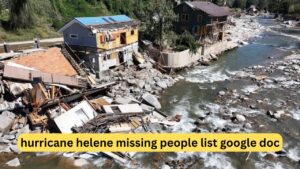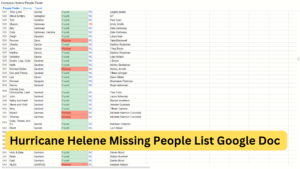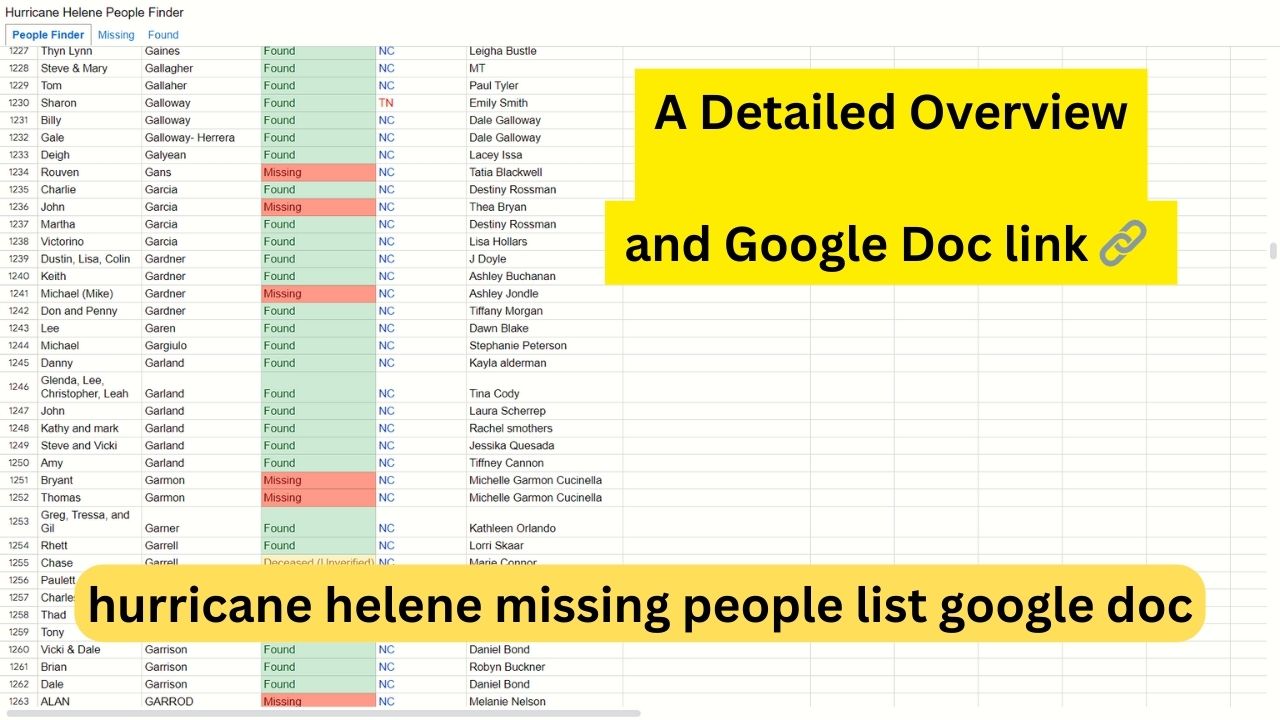Hurricane Helene: Ongoing Search for Missing People as Death Toll Continues to Rise
Google Doc – Link Click Here’s
As Hurricane Helene ravaged through the Atlantic coast, the aftermath has left an unsettling scenario of devastation, with an unknown number of people still missing. This catastrophic natural disaster has led to widespread damage, displacing thousands and leaving communities grappling with the traumatic consequences. With the death toll rising, there is a significant concern over the missing persons list, as families and authorities intensify search efforts to locate those unaccounted for.
The Immediate Impact of Hurricane Helene
Hurricane Helene made landfall with ferocious winds, torrential rain, and a storm surge that overwhelmed coastal areas. What started as a category 3 storm rapidly escalated, leaving behind a trail of destruction. The hardest-hit areas saw widespread flooding, homes submerged underwater, and entire communities isolated due to damaged infrastructure.

The storm’s initial impact took out power lines, communication networks, and transportation routes, making it exceedingly difficult for emergency services to respond quickly. The devastation led to thousands of missing people within the first few days, while rescue operations were delayed by hazardous weather conditions and impassable roads.
The Growing Number of Missing People
In the wake of Hurricane Helene, families and authorities have reported a growing number of missing individuals. The list, initially manageable, has ballooned as more regions report individuals who have not been heard from since the storm hit. These missing persons come from all walks of life, including elderly residents, children, and those with limited mobility who may have been unable to evacuate in time.
Hurricane Helene Missing People List Google Doc 1!: A Detailed Overview
Efforts to compile a comprehensive missing people list are ongoing, with officials relying on social media platforms, hotlines, and community outreach to gather as much information as possible. The reality, however, remains grim as the number of those unaccounted for continues to rise.
Challenges in Locating the Missing
The search for missing people post-Hurricane Helene is fraught with challenges. One of the biggest obstacles is the sheer scale of the destruction. Floodwaters have made some areas inaccessible, and in many cases, debris and wreckage have buried homes and vehicles, making it difficult to determine whether anyone is trapped beneath.

Additionally, the lack of power and communication has made it difficult to establish contact with people who may still be in isolated areas. Emergency response teams have been using drones, boats, and helicopters to survey the hardest-hit regions, but progress has been slow. With each passing day, the hope of finding survivors diminishes.
Rescue and Recovery Efforts Intensified
Despite the overwhelming challenges, authorities and humanitarian organizations have ramped up rescue and recovery efforts in a bid to locate the missing and bring relief to survivors. Search-and-rescue teams, many working around the clock, have been deployed to sift through the wreckage and reach stranded individuals.
Emergency shelters have been set up in key regions to accommodate those displaced, and rescue crews have been using satellite technology to coordinate their efforts in real-time. However, due to the scale of the devastation and the unknown number of people still unaccounted for, these efforts are expected to continue for several weeks, if not longer.
Community-Led Search Initiatives
In addition to official rescue operations, many communities have launched their own efforts to locate missing friends and family members. Local residents have banded together to search through neighborhoods, post flyers, and share information on social media in the hope of finding their loved ones.
This sense of solidarity has been a beacon of hope for many, as it demonstrates the resilience and unity of those affected by the disaster. However, community-led searches are often hindered by a lack of resources, expertise, and the unpredictable nature of the storm’s aftermath.
Death Toll on the Rise
While the focus remains on locating survivors, the rising death toll has been a sobering reminder of the storm’s deadly impact. As of the latest reports, the official death toll stands at over 500, but experts believe that this number will continue to climb as more bodies are recovered from the debris.

Many of the fatalities have been attributed to drowning, while others are a result of injuries sustained during the storm or exposure to the elements in the days following the hurricane. For families who have already received the devastating news of their loved ones’ deaths, closure remains elusive as they grapple with the enormity of their loss.
Efforts to Update the Missing People List
The missing persons list is constantly evolving, with names being added and removed as people are located or confirmed dead. This ongoing process is being meticulously managed by both local authorities and national agencies to ensure accuracy and avoid confusion. However, the scale of the disaster has made it difficult to provide real-time updates, further compounding the anguish of those still waiting for news of their loved ones.
Long-Term Impacts of Hurricane Helene
The aftermath of Hurricane Helene will likely be felt for years to come. Beyond the immediate devastation, the hurricane has upended the lives of countless families and left entire communities struggling to rebuild. As the recovery process begins, many are left grappling with the emotional toll of losing loved ones and the uncertainty surrounding the fate of those still missing.
Infrastructure Damage and Economic Consequences
One of the most visible impacts of the hurricane has been the destruction of critical infrastructure. Roads, bridges, and utilities have been severely damaged, making it difficult for aid to reach the most affected areas. Rebuilding efforts are expected to cost billions of dollars, and it could take years before the region fully recovers.
The economic consequences are also profound. Many businesses have been destroyed or severely damaged, leaving people without jobs and sources of income. The agricultural sector, in particular, has been hit hard, with crops and livestock lost to the storm.

Psychological Impact on Survivors
For those who have survived the storm, the psychological scars will likely last long after the physical damage has been repaired. Survivors of Hurricane Helene are dealing with the trauma of losing loved ones, the uncertainty of the missing, and the fear of facing another disaster in the future.
Mental health services are already being stretched thin, with counselors and support groups working to help survivors process their grief and trauma. Long-term mental health support will be crucial for these communities as they begin the slow process of rebuilding their lives.
Environmental Consequences of Hurricane Helene
The environmental damage left behind by Hurricane Helene is extensive, with lasting implications for ecosystems, wildlife, and local habitats. The storm caused widespread flooding, which has introduced contaminants into rivers, lakes, and coastal waters. This has resulted in polluted water supplies, affecting not only humans but also animals that rely on these bodies of water for survival.
Coastal Erosion and Habitat Destruction
One of the most severe impacts of Hurricane Helene has been the erosion of coastal areas. The strong winds and surging waves have stripped away beaches, destroyed coral reefs, and left many coastal ecosystems in a fragile state. Wildlife, including endangered species, has been affected as their habitats have been either destroyed or drastically altered by the storm. Mangroves, which play a crucial role in protecting coastal regions from storm surges, have been severely damaged, further exposing these areas to future natural disasters.
Inland, the massive flooding has led to landslides and soil erosion, which have not only affected human settlements but also damaged agricultural lands. The loss of fertile soil could take years to recover, further hampering the region’s economy and food production capabilities.
Marine Life Impact
Marine life has also suffered greatly from the storm. Hurricanes often displace fish populations, destroy coral reefs, and disrupt marine ecosystems. The storm’s aftermath has led to a significant decline in fish stocks, which local communities depend on for their livelihoods. In addition, oil spills and the runoff of toxic chemicals from flooded industrial areas have further contaminated the ocean waters, leading to large-scale deaths of marine creatures.
The long-term recovery of these ecosystems is uncertain, and it may take decades before they can return to their pre-hurricane conditions.
Rebuilding Efforts and Government Response
The scale of the destruction caused by Hurricane Helene has prompted swift action from governments and international relief organizations. However, the recovery process will be a massive and long-term undertaking. Infrastructure repair, restoring utilities, and rebuilding homes will require significant financial investments, while emergency relief efforts focus on providing food, water, and medical assistance to those affected.
Federal Aid and International Assistance
In the aftermath of the storm, the government has declared a state of emergency, freeing up federal resources to support local efforts. This includes deploying the National Guard to assist in search and rescue operations, as well as funding for rebuilding critical infrastructure like hospitals, schools, and roads.
International aid has also poured in from various countries and organizations, offering not only financial assistance but also essential supplies like clean water, food, and medical equipment. However, the sheer scale of the disaster has overwhelmed even the most robust relief efforts, and many areas are still waiting for help.
Long-Term Reconstruction Plans
The government has announced a long-term plan to rebuild the affected regions, focusing on making them more resilient to future natural disasters. This includes upgrading infrastructure to withstand hurricanes, reinforcing coastal defenses, and implementing more effective evacuation plans to ensure that communities are better prepared for the next storm.
Community-Led Rebuilding Initiatives
In addition to government efforts, local communities have taken it upon themselves to rebuild. Many grassroots organizations have formed to provide immediate relief to affected families and help rebuild homes. Volunteers from across the country have arrived to assist in clearing debris, distributing aid, and offering emotional support to survivors.
These community-led initiatives are often the most effective, as they operate with a deep understanding of the local needs and challenges. Their efforts are crucial in helping rebuild the social fabric of these communities, offering hope and solidarity in a time of crisis.
Preparing for Future Hurricanes
While the region focuses on recovery from Hurricane Helene, there is a growing recognition that more needs to be done to prepare for future storms. With climate change increasing the frequency and intensity of hurricanes, communities along the coast must adapt to a new reality where such disasters may become more common.

Climate Resilience Initiatives
Governments and environmental organizations are advocating for stronger climate resilience measures, such as building storm-resistant infrastructure, improving early warning systems, and protecting natural barriers like wetlands and mangroves. Investment in these areas can help mitigate the impact of future hurricanes and protect vulnerable communities from the worst effects of climate change.
Public Awareness and Education
Educating the public on hurricane preparedness is also crucial. The lack of awareness or delayed action during Hurricane Helene contributed to the high number of missing persons and casualties. Going forward, public education campaigns will play a key role in ensuring that residents know how to respond in the event of another major storm. This includes clear guidelines on evacuation procedures, securing homes, and preparing emergency kits.
Moving Forward from the Devastation
The aftermath of Hurricane Helene will continue to be felt for many years to come. As rescue efforts persist, and as families wait for news of missing loved ones, communities are beginning the long and difficult process of rebuilding their lives. The devastation caused by this hurricane has been immense, but with continued support from the government, international aid, and community solidarity, there is hope for recovery.
While the road ahead will be challenging, the lessons learned from Hurricane Helene will play a vital role in how communities prepare for future disasters. By investing in resilience, fostering public awareness, and maintaining a united front in the face of adversity, we can work toward a safer and more prepared future.
Conclusion
As the death toll continues to rise and the number of missing people remains uncertain, the aftermath of Hurricane Helene is a stark reminder of the destructive power of nature. While rescue and recovery efforts are ongoing, the full extent of the storm’s impact may not be known for weeks or even months. For now, families across the region are holding out hope that their loved ones will be found, as communities band together to begin the long journey toward recovery.
